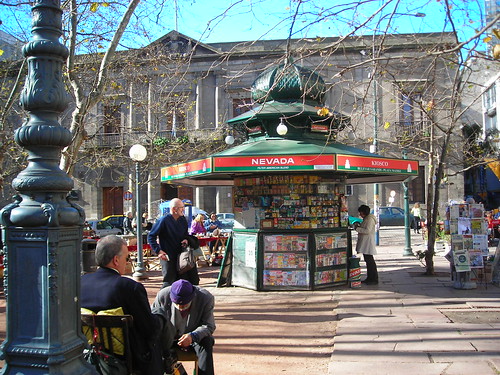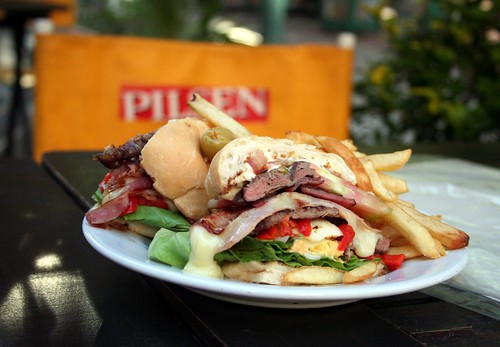
Montevideo is one of the travel destinations in this part of the continent of South America. In which thousands and thousands of tourists return every year to visit the city. The best way to know the city of Montevideo is walking. As widespread ideally divided into zones or know cycling. If this is your first time and not many days, starting with the Old Town and follow the Avenue July 18 until Parque Batlle (but probably will take two days to make this journey on foot). In Old Town do not miss the Mercado del Puerto whose traditional style, with wrought-iron structure, reminiscent of old European train stations (and if you can eat a rich barbecue).
Art and Culture in the Old City:
Around the Matrix Plaza Old Town (located on a peninsula on the banks of the river) is where the old colonial buildings still remain hidden in banks and offices. There is the Cathedral, the Cabildo and museums such as the Torres Garcia, a Uruguayan artist named creator of Universal Constructivism. There is also the Teatro Solis, opened in 1856, whose facade is inspired by the Teatro Carlo Felice in Genoa. Pedestrian right there Sarandí arises, as the whole neighborhood, became a beautiful nightclub after years of neglect. The entrance to the pedestrian is a vestige of the colonial past: the Gate of the Citadel, the only remnant of the demolished wall of Montevideo in 1829. Across the Plaza Independencia is the equestrian statue unmistakable Gervasio Artigas.

Parque Rodo:
With independence urban transformations were made to erase the colonial past and one of them was to trace the current July 18th Av, a date which marks the Constitution Day of 1830. «The» avenue of Montevideo was born in Independence Square and is filled with shops, hotels, bars and bookstores. At the corner of the avenue and the square is a symbol of the city: the Palacio Salvo, opened in 1928. This 95-meter building was designed by Mario Palanti (Parque Rodo tor of Palacio Barolo in Buenos Aires) and was long the highest in South America. That site was the tearoom La Giralda where Gerardo Matos Rodriguez presented the most famous Uruguayan tango, «La Cumparsita.» From the square, runs July 18 about three miles to the Bulevar Artigas in the neighborhood Tres Cruces, where the Obelisk, and one of the entrances to the Parque Batlle. Along the way are Cagancha Square (kilometer zero of the domestic routes), the imposing building of the Supreme Court of Justice (former home of businessman Francisco Piria Uruguay), City Hall and beyond, the Monument to Gaucho the Uruguayan sculptor José Luis Zorrilla de San Martin (father of actress China Zorrilla), the source of the Boulevard Pocitos reaching Spain. The avenue continues towards Tristan Narvaja (street of traditional flea market on Sundays) and ends at Parque Batlle y Ordóñez where stands the legendary centenary. At this stage (built for the centennial of Independence) Uruguay won the final of the first World Cup. The park was designed by French landscaper Carlos Thays and it is the Monument to José Belloni Wagon.

Tours of La Rambla:
La Rambla is a long coastal avenue and promenade ideal for jogging, biking or drink mate as all Uruguayans. Along its route changes names, beach and neighborhood. Departing from the Old Town and South Town arrived in Palermo, a neighborhood that housed large numbers of immigrants (mostly Italians) until the first decades of the twentieth century. Here’s your place the African American community, creator of the conga. Its members tend to gather around the Central Cemetery to play the drums and preparing for the Carnival parade Call. When President Wilson called Rambla is in the Barrio Parque Rodo (homage to the Uruguayan writer Jose Enrique Rodo) green space which occupies much of the district. There is the Playa Ramirez, the former Park Hotel (now the headquarters of Mercosur) and Summer Theatre where he performed the official competition of the Carnival. As you know, the Carnival (the longest in the world because it takes almost 40 days) is the most important event in Uruguay since the total admissions than the sum of all cultural and sporting events in the country’s year.

Going further you will reach the Rambla Gandhi and Punta Carretas neighborhood named for its prominent geographical feature (also Punta Brava). For a long time the area was frequented only by washers and fishermen. It was a marginal area to the point that, in 1915, opened a penitentiary that years later saw the movie several leaks: the anarchists in the ’30s and the Tupamaros in the ’70s. In 1986 a major prison riot caused was evacuated and closed for good. Only in 1994 was transformed into a shopping center and in the meantime, the district was consolidated as an upper middle class neighborhood.
Pocitos is a traditional neighborhood with beach and is located at the height of the Rambla Republic of Peru. Its name comes from the years (the early nineteenth century) in which the washers went to the beach and washed the clothes in wells that were in the sand. Born as an independent town, while growing the city became a resort and then upper-class neighborhood, with individual homes which were later replaced by buildings of 10 to 15 stories overlooking the «sea» as called Montevideo to Rio Plate. Continuing along the Rambla Armenia will reach the beach where they landed Diving in 1807, the English who took Montevideo and as Pocitos, growth took off as a resort in the twentieth century.
Another area on the coast is Carrasco, named after one of the first settlers of Montevideo, which had stayed there. Between 1907 and 1912 he created the garden district «Balneario Carrasco» (designed by Carlos Thays) but slowed the work of the First World War and continued by the municipality. In 1921 he opened the Hotel Casino Carrasco and began to emerge luxurious summer homes that later became permanent home of the elite.
El Cerro, the Fortress and the gouache:
Rica is the history of Villa del Cerro emerged in 1834 to house thousands of immigrants. The district is in the north and east slopes of Cerro Montevideo and here was such a proliferation of licks in the nineteenth century and refrigerators in the twentieth became a banner of Uruguayan meat industry. The golden age was in 1937 (when almost all of its inhabitants lived, directly or indirectly, for the meat) and the decline occurred in the mid 50s to immigration and the withdrawal of the Swift. Then there was some cooperatives but the final blow came in 1978 when the government abolished the monopoly on dictatorial National Fridge (created by the State in 1928) and freed prices. Thus ended an era in El Cerro and its inhabitants had to seek employment in other parts of the city. In the ’90s, wanted to recycle the skeletons of old refrigerators and in 1996 the Uruguayan army set up its naval base in the old Fridge Swift.
If we go back to the origins of the city, the Cerro de Montevideo was always a strategic point of defense. The British invasions of 1807 led to the construction (between 1809 and 1811) of the current Fortaleza General Artigas. The Fortress is one of the symbols of Montevideo and one of the most visited tours as it offers the best view of the city. However, the area is not safe and is advised to go during the day and by car, avoiding walking up.
La Aguada is close to downtown and its name dates from the mid eighteenth century there were several water sources. Some symbols of the district are Central General Artigas Station (main terminal of the country now in disuse) and the Telecommunications Tower, where 162 meters modernism and its contrast with the old warehouses that surround it. However, the most beautiful building in the neighborhood (and Montevideo) is the Legislative Palace, inaugurated in 1925 and work of Vittorio Meano (author of the Congress in Buenos Aires). This monumental and harmonious construction is worth a visit inside to see beautiful stained glass, colored marble and sleek furnishings. From there, Agraciada Avenida Diagonal, you can go to the Prado Park.
Cuisine:
Be sure to try a «goat» or bread plate (can be beef, chicken or pork) in any shopping street. Also a hot dog in the passive (with mustard house whose formula is a secret) and, for dessert, ice cream at The Cigalle. The pizza is very good and is sold per meter or in portions (Il Mondo Della Pizza, 922 Avenue July 18). Another miss is the toasted sandwich covered with melted mozzarella in any bar.

Good Luck of Travel to Uruguay.
Leave a Reply
You must be logged in to post a comment.
Recent Comments